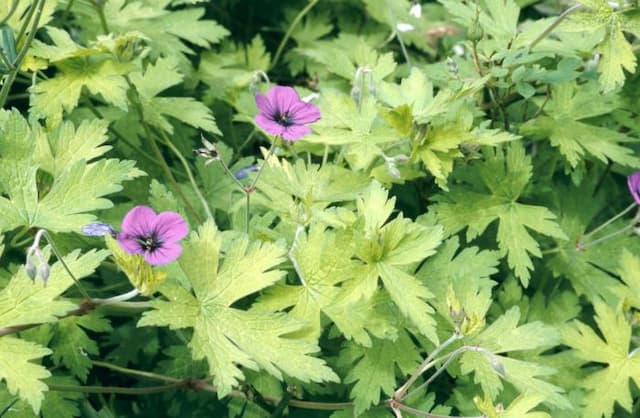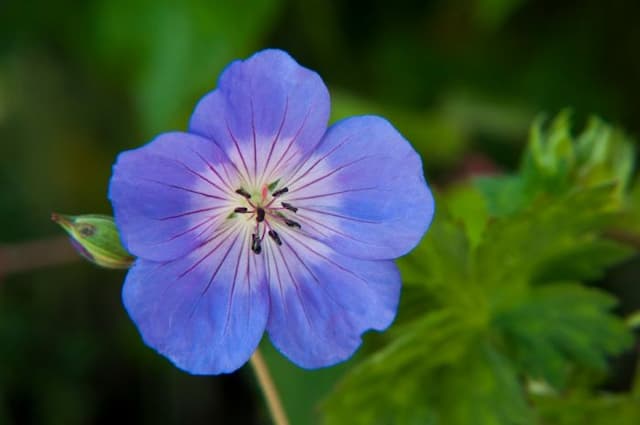Kashmir Geranium Geranium clarkei (Purple-flowered Group) 'Kashmir Purple'

ABOUT
'Kashmir Purple' is a variety of the hardy geranium known for its alluring appearance. This plant showcases a rich display of deeply cut, lacy leaves that create a feathery backdrop for its flowers. The foliage tends to be dense and can form a lush mound, which becomes a focal point in any garden setting. Throughout the blooming season, 'Kashmir Purple' is adorned with large, saucer-shaped flowers. These blooms come in a striking shade of violet-purple, often with delicate veins that can appear darker or lighter than the petal background. The petals are rounded with slight notches at the tips, giving them a gentle, ruffled look. At the center of each bloom, small clusters of prominent stamens add a contrasting touch, usually in a lighter hue, which can attract pollinators like bees and butterflies. This vibrant geranium variety exudes a cottage garden charm and adds a splash of cool-toned color to plantings and borders.
About this plant
 Names
NamesSynonyms
Kashmir Geranium, Clarke's Geranium.
Common names
Geranium clarkei 'Kashmir Purple'
 Toxicity
ToxicityTo humans
The geranium known as 'Kashmir Purple' is not considered toxic to humans. Generally, geraniums are often used in gardens and homes without any issues regarding human toxicity. Ingesting parts of the plant is unlikely to cause more than mild gastrointestinal upset, if any symptoms occur at all.
To pets
The 'Kashmir Purple' geranium is also not considered toxic to pets. Geraniums, in general, are safe around pets and there are no widespread reports of significant toxicity in animals after ingestion. However, it’s always prudent to keep an eye on pets as individual reactions can vary and excessive ingestion of any plant material could potentially cause mild gastrointestinal discomfort.
 Characteristics
CharacteristicsLife cycle
Perennials
Foliage type
Deciduous
Color of leaves
Green
Flower color
Purple
Height
1-2 feet (30-60 cm)
Spread
1-2 feet (30-60 cm)
Plant type
Herb
Hardiness zones
5
Native area
Himalayas
Benefits
 General Benefits
General Benefits- Attracts Pollinators: Geranium clarkei 'Kashmir Purple' is known for attracting bees and butterflies, which is beneficial to the ecosystem for pollination.
- Easy to Grow: This plant is considered low-maintenance, making it suitable for gardeners of all skill levels.
- Drought Tolerant: Once established, 'Kashmir Purple' can tolerate periods of dryness, reducing the need for frequent watering.
- Colorful Foliage: The plant provides attractive foliage throughout the growing season, adding visual interest to the garden.
- Long Blooming Period: It produces flowers over a long season, from late spring to early fall, ensuring a continuous display of color.
- Deer and Rabbit Resistant: The plant tends to be resistant to browsing by deer and rabbits, making it suitable for areas with wildlife pressure.
- Soil Adaptability: It grows well in a variety of soil types, though it prefers well-drained soil, making it adaptable to different garden conditions.
- Border Planting: Suitable for use in borders, the plant can help define garden spaces and pathways with its clumping habit.
- Groundcover: Its spreading nature makes it an effective groundcover, helping to suppress weeds and cover bare spots in the garden.
- Cottage/Informal Garden Suitable: The plant fits well into cottage and informal garden settings due to its naturalistic appearance.
 Medical Properties
Medical PropertiesThis plant is not used for medical purposes.
 Air-purifying Qualities
Air-purifying QualitiesThis plant is not specifically known for air purifying qualities.
 Other Uses
Other Uses- As a natural dye: The petals of Geranium clarkei can be used to create a gentle, violet-hued dye for fabrics or art projects.
- In companion planting: Geranium clarkei can be planted alongside vegetables and herbs to attract beneficial insects and repel pests.
- As a potpourri ingredient: The dried flowers and leaves emit a pleasant scent and can add a pop of color to homemade potpourri mixtures.
- In culinary creations: While not commonly used in cooking, the petals of Geranium clarkei can be crystallized or used as edible garnishes for desserts.
- As a natural fabric freshener: Dried leaves and flowers can be tucked into sachets to freshen up closets and drawers.
- For educational purposes: This plant can be used in botanical studies and gardening workshops focused on perennial plant cultivation and propagation.
- In crafting: The flowers can be pressed and used in various crafts like handmade paper or botanical prints.
- As decoration in aquariums: While not an aquatic plant, the leaves can be placed in aquariums to offer a more natural environment for fish until they decompose.
- In flower arrangements: Geranium clarkei can add depth and contrast when used in cut flower arrangements due to its vibrant purple color.
- As a photography subject: The stunning purple flowers provide a striking subject for photographers specializing in botanical and landscape imagery.
Interesting Facts
 Feng Shui
Feng ShuiThe Geranium is not used in Feng Shui practice.
 Zodiac Sign Compitability
Zodiac Sign CompitabilityThe Geranium is not used in astrology practice.
 Plant Symbolism
Plant Symbolism- Unexpected Meeting: Geraniums are sometimes associated with encounters that one does not anticipate, signifying the pleasant surprises life can bring.
- Steadfastness: The geranium's hardiness and ability to flourish in a variety of situations symbolize a person's ability to persevere through challenges.
- Friendship: Due to their long-lasting nature in bloom, geraniums can be reflective of enduring friendship and the deep bonds formed between people.
- Fertility: Their lush and generous growth could be seen as a representation of fertility and abundance.
- Protection: Some cultures consider geraniums as plants that provide protection against negative influences.
- Health: Often planted in home gardens, geraniums are thought to promote health and recovery.
 Water
WaterKashmir Purple geraniums should be watered deeply whenever the top inch of soil feels dry to the touch, generally about once a week during active growth seasons, spring and summer. In hotter climates or during dry spells, monitoring the soil moisture is critical; you might need to water twice a week. Use approximately one to two gallons of water for outdoor plants, ensuring it penetrates the soil well without leaving the plant waterlogged. During the winter months, reduce watering as the plant requires less moisture when growth slows. Always avoid overhead watering to minimize the risk of leaf diseases.
 Light
LightKashmir Purple geraniums thrive best in full sun to partial shade conditions. A spot that receives morning sunlight and afternoon shade is ideal, particularly in hot climates to prevent the leaves from scorching. When grown indoors, a south or west-facing window that provides at least 4-6 hours of sunlight daily will help maintain healthy growth and flowering.
 Temperature
TemperatureKashmir Purple geraniums prefer moderate temperatures and can tolerate a range from approximately 60 to 75 degrees Fahrenheit. However, they are hardy and can survive temperatures down to about 20 degrees Fahrenheit, although growth will be inhibited. Ideal growing conditions would not exceed 85 degrees Fahrenheit to prevent heat stress, especially during the peak summer months.
 Pruning
PruningPrune Kashmir Purple geraniums to encourage bushier growth, remove dead or yellowing leaves, and improve air circulation. The best time to prune is in late winter or early spring, just before new growth begins. Deadhead spent flowers regularly during the blooming season to promote continuous blooms. Pruning can be done as needed throughout the growing season to maintain shape and health of the plant.
 Cleaning
CleaningAs needed
 Soil
SoilThe best soil mix for Kashmir Purple geranium should be well-draining and fertile, with a mixture of loam, peat, and sharp sand to facilitate drainage. The preferred soil pH is slightly acidic to neutral, ranging from 5.8 to 7.0.
 Repotting
RepottingKashmir Purple geraniums typically require repotting every two to three years or when the root system outgrows the current pot, to ensure sufficient space for growth and prevent root-bound conditions.
 Humidity & Misting
Humidity & MistingKashmir Purple geraniums tolerate a wide range of humidity levels but prefer moderate conditions; they do not require high humidity environments to thrive.
 Suitable locations
Suitable locationsIndoor
Place in bright, indirect light with well-draining soil mix.
Outdoor
Plant in partial shade, enrich soil, and provide good drainage.
Hardiness zone
5-8 USDA
 Life cycle
Life cycleGeranium clarkei 'Kashmir Purple' begins its life cycle as a seed, which upon germinating in a suitable environment, will develop into a small seedling. The seedling grows into a vegetative plant that establishes a root system and foliage through the process of photosynthesis. As it matures, the geranium enters the flowering stage, where it produces distinctive purple flowers that attract pollinators, leading to the process of pollination. After successful pollination, the flowers develop into fruits, which contain seeds ready for dispersal. The seeds are then spread by various means, such as through wind, water, or by animals, and once reaching a conducive environment, they will germinate and start a new life cycle. During winter or unfavorable conditions, the plant goes dormant, retreating into its roots, but it emerges again in spring to repeat the cycle.
 Propogation
PropogationPropogation time
Late summer
The most popular method of propagation for Geranium clarkei 'Kashmir Purple', commonly known as Kashmir Purple cranesbill, is through division. This involves separating the plant into smaller pieces, each with its own root system. The best time to divide cranesbills is in early spring or fall when the plant is not in active growth. To propagate by division, gently lift the plant from the ground with a spade, ensuring to keep as much of the root system intact as possible. Then, using a sharp knife or spade, cut the plant into sections ensuring each section has at least one growth point or shoot. Replant the divisions promptly, spacing them about 12 inches (approximately 30 centimeters) apart to give each new plant enough room to grow. Water the new plants thoroughly after planting to help them establish.









